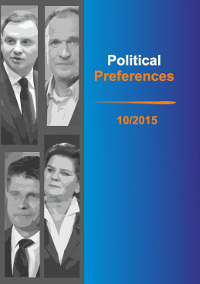Adamik-Szysiak M. (2012), Telewizyjna reklama polityczna w Polsce w latach 2005-2010, Lublin: Wydawnictwo Uniwersytetu Marii Curie-Skłodowskiej.
Google Scholar
Adamik-Szysiak M. (2014), Audiovisual political advertising in communication strategies of Polish political parties: The case of the parliamentary campaign in 2011, “Polish Journal of Communication” 2014, vol. 7, no. 2(13).
Google Scholar
Biocca F. (1991), Looking for units of meaning in political ads, [in:] Frank Biocca (ed.), Television and political advertising, Hillsdale: Lawrence Erlbaum Associates.
Google Scholar
BS/156/2011, Społeczny odbiór kampanii wyborczej i aktywność polityczna w Internecie. Raport z badań, Warszawa: Centrum Badania Opinii Społecznej.
Google Scholar
BS/178/2014, Odbiór kampanii wyborczej i przedwyborcza aktywność polityczna w Internecie. Raport z badań, Warszawa: Centrum Badania Opinii Społecznej.
Google Scholar
Cwalina W. (2004), Polityczna reklama negatywna, [w:] Marek Jeziński (red.), Marketing polityczny. W poszukiwaniu strategii wyborczego sukcesu, Toruń: Wydawnictwo DUET.
Google Scholar
Cwalina W., Falkowski A. (2005), Marketing polityczny. Perspektywa psychologiczna, Gdańsk: Gdańskie Wydawnictwo Psychologiczne.
Google Scholar
Cześnik M., Kotnarowski M. (2011), Nowy wymiar politycznego współzawodnictwa: Polska solidarna versus Polska liberalna, „Studia Polityczne” 2011, nr 27.
Google Scholar
Dobek-Ostrowska B. (2009), Porozumienie czy konflikt? Politycy, media i obywatele w komunikowaniu politycznym, Warszawa: PWN.
Google Scholar
Gronbeck B.E. (1994), Negative Political Ads and American Self Images, [in:] Arthur H. Miller, Bruce E. Gronbeck (eds.), Presidential Campaigns & American Self Images, Oxford: Westview Press.
Google Scholar
Johnson-Cartee K.S., Copeland G.A. (1991), Negative political advertising, Hillsdale: Lawrence Erlbaum.
Google Scholar
Kaid L.L. (2004), Political Advertising, [in:] Lynda Lee Kaid (ed.), Handbook of political communication research, Mahwah – New Jersey – London: Lawrence Erlbaum Associates.
Google Scholar
Kaid L.L., Johnston A. (2001), Presidential Campaigns. Style and Content of Televised Political Advertising, Westport: Praeger.
Google Scholar
KRRiT (2005a), Informacja o wydatkach i wykorzystaniu czasu antenowego w radiu i telewizji na emisje płatnych ogłoszeń wyborczych zleconych przez komitety wyborcze w trakcie kampanii wyborczej do Sejmu i Senatu RP w 2005 roku.
Google Scholar
KRRiT (2005b), Informacja o wydatkach i wykorzystaniu czasu na emisję odpłatnych audycji wyborczych podczas kampanii wyborczej na urząd prezydenta RP.
Google Scholar
KRRiT (2011), Informacja o wydatkach i wykorzystaniu czasu antenowego w radiu i telewizji na emisje płatnych ogłoszeń wyborczych zleconych przez komitety wyborcze w trakcie kampanii wyborczej do Sejmu i Senatu Rzeczypospolitej Polskiej w 2011 r., Analiza Biura KRRiT nr 5.
Google Scholar
Lau R.R., Sigelman L., Heldman C., Babbitt P. (1999), The effects of negative political advertisements: A meta-analytic assessment, “American Political Science Review” 1999, vol. 93.
Google Scholar
Mazur M. (2007), Marketing polityczny: studium porównawcze prezydenckich kampanii wyborczych w USA i w Polsce, Warszawa: Wydawnictwo Naukowe PWN.
Google Scholar
Merritt S. (1984), Negative political advertising: Some empirical findings, “Journal of Advertising” 1984, vol. 13(3).
Google Scholar
Olczyk T. (2009), Politrozrywka i popperswazja. Reklama telewizyjna w polskich kampaniach wyborczych XXI wieku, Warszawa: Wydawnictwa Akademickie i Profesjonalne.
Google Scholar
Olszanecka A. (2014), Ewolucja strategii marketingowych polskich partii politycznych 1989-2011 – od Studia Wyborczego do reklamy internetowej, „Polityka i Społeczeństwo” 2014, nr 3(12).
Google Scholar
Pietraś Z.J. (1998), Decydowanie polityczne, Warszawa – Kraków: Wydawnictwo PWN.
Google Scholar
Richardson G. (2002), Visual storytelling and the competition for political meaning in political advertising and news in campaign 2000, “American Communication Journal” 2002, vol. 5.
Google Scholar
Schultz W. (2006), Komunikacja polityczna. Koncepcje teoretyczne i wyniki badań empirycznych na temat mediów masowych w polityce, Kraków: Wydawnictwo Uniwersytetu Jagiellońskiego.
Google Scholar
Skarżyńska K. (2005), Człowiek a polityka. Zarys psychologii politycznej, Warszawa: Wydawnictwo Scholar.
Google Scholar
Stewart Ch.J. (1975), Voter perceptions of mudslingling in political communication, “Central States Speech Journal” 1975, vol. 26.
Google Scholar



 10.31261/polpre
10.31261/polpre